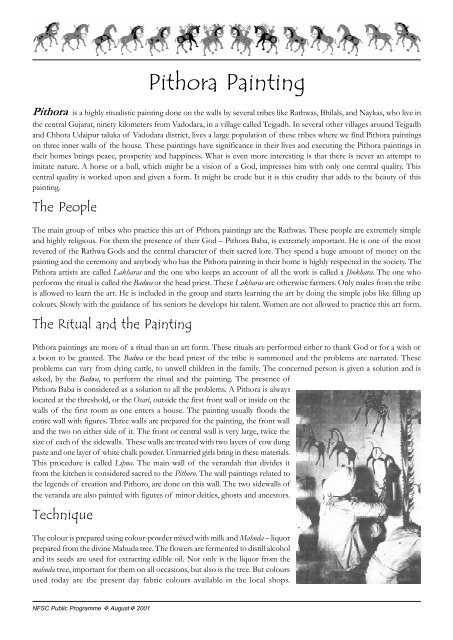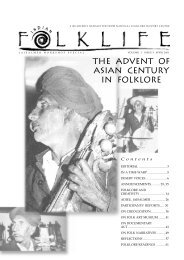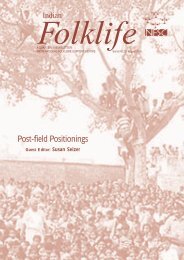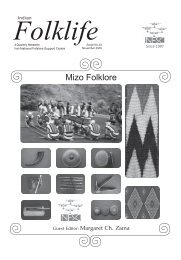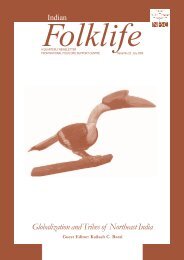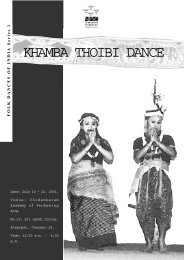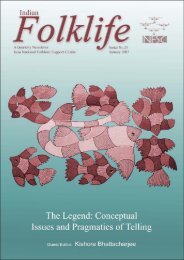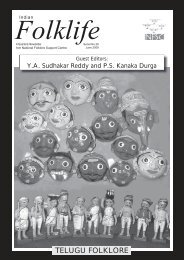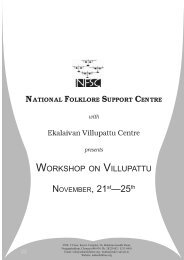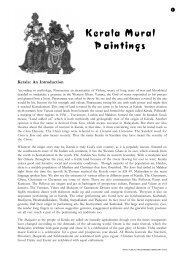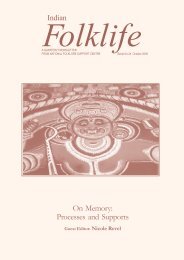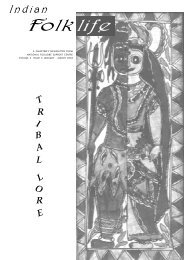Pithora Painting - Wiki - National Folklore Support Centre
Pithora Painting - Wiki - National Folklore Support Centre
Pithora Painting - Wiki - National Folklore Support Centre
- No tags were found...
Create successful ePaper yourself
Turn your PDF publications into a flip-book with our unique Google optimized e-Paper software.
<strong>Pithora</strong> <strong>Painting</strong><strong>Pithora</strong> is a highly ritualistic painting done on the walls by several tribes like Rathwas, Bhilals, and Naykas, who live inthe central Gujarat, ninety kilometers from Vadodara, in a village called Tejgadh. In several other villages around Tejgadhand Chhota Udaipur taluka of Vadodara district, lives a large population of these tribes where we find <strong>Pithora</strong> paintingson three inner walls of the house. These paintings have significance in their lives and executing the <strong>Pithora</strong> paintings intheir homes brings peace, prosperity and happiness. What is even more interesting is that there is never an attempt toimitate nature. A horse or a bull, which might be a vision of a God, impresses him with only one central quality. Thiscentral quality is worked upon and given a form. It might be crude but it is this crudity that adds to the beauty of thispainting.The PeopleThe main group of tribes who practice this art of <strong>Pithora</strong> paintings are the Rathwas. These people are extremely simpleand highly religious. For them the presence of their God – <strong>Pithora</strong> Baba, is extremely important. He is one of the mostrevered of the Rathwa Gods and the central character of their sacred lore. They spend a huge amount of money on thepainting and the ceremony and anybody who has the <strong>Pithora</strong> painting in their home is highly respected in the society. The<strong>Pithora</strong> artists are called Lakharas and the one who keeps an account of all the work is called a Jhokhara. The one whoperforms the ritual is called the Badwa or the head priest. These Lakharas are otherwise farmers. Only males from the tribeis allowed to learn the art. He is included in the group and starts learning the art by doing the simple jobs like filling upcolours. Slowly with the guidance of his seniors he develops his talent. Women are not allowed to practice this art form.The Ritual and the <strong>Painting</strong><strong>Pithora</strong> paintings are more of a ritual than an art form. These rituals are performed either to thank God or for a wish ora boon to be granted. The Badwa or the head priest of the tribe is summoned and the problems are narrated. Theseproblems can vary from dying cattle, to unwell children in the family. The concerned person is given a solution and isasked, by the Badwa, to perform the ritual and the painting. The presence of<strong>Pithora</strong> Baba is considered as a solution to all the problems. A <strong>Pithora</strong> is alwayslocated at the threshold, or the Osari, outside the first front wall or inside on thewalls of the first room as one enters a house. The painting usually floods theentire wall with figures. Three walls are prepared for the painting, the front walland the two on either side of it. The front or central wall is very large, twice thesize of each of the sidewalls. These walls are treated with two layers of cow dungpaste and one layer of white chalk powder. Unmarried girls bring in these materials.This procedure is called Lipna. The main wall of the verandah that divides itfrom the kitchen is considered sacred to the Pithoro. The wall paintings related tothe legends of creation and Pithoro, are done on this wall. The two sidewalls ofthe veranda are also painted with figures of minor deities, ghosts and ancestors.TechniqueThe colour is prepared using colour-powder mixed with milk and Mahuda – liquorprepared from the divine Mahuda tree. The flowers are fermented to distill alcoholand its seeds are used for extracting edible oil. Not only is the liquor from themahuda tree, important for them on all occasions, but also is the tree. But coloursused today are the present day fabric colours available in the local shops.NFSC Public Programme v Augustv 2001
The main colours are yellow, indigo, orange, green, vermilion, red,ultramarine, black and silver. The brush is prepared by either chewing orby beating the ends of a bamboo stick or a twig. Again modern brusheshave replaced the traditional one. They are not worried about the surface,texture, the quality of material or the medium and the style.Myths and SubjectsThe main myth is painted within a cok or a dhartini hadh, or a sacred enclosure,which is a rectangular space, bound on all four sides by ornate borders.The sacred enclosure contains the pictorial depiction of the mythology ofthe Rathwas. Generally the uppermost section of the enclosure, above a wavy line with geometric motifs, represents theworld of Gods. Just below this line there is the procession of the marriage of Pithoro. Pithoro’s marriage with Pithori isone of the most important aspects of the recited and the painted legend. Popularly the painted enclosure is described as<strong>Pithora</strong> bapjinu aykhu, or the life of <strong>Pithora</strong>’s father.In the center they have a smaller rectangle where they make orange dots with the fingers, called Tipna, which is done at theend of the ritual when the painting is complete. Near the tipna, the God <strong>Pithora</strong> is painted and then his wife Pithori. Ontop, the Sun, the Moon, monkeys and other figures are drawn. Horizontally, there are three rows, and the central row of<strong>Pithora</strong> and tipna are the most important. The last row has figures like elephants, with Raja Bhoj. Near the tigers they offera live goat and wine. To the right side they paint Khatri horses— which are the horses of their ancestors, in a vertical row.On the left wall, they draw two white horses, which are for ghosts, and witches, who have to be satisfied with gifts andhorses. The lower half of the enclosure depicts the actual myth of creation wherein the Earth, the mythical farmer, thecowherd, the kings, the bania, the badvo, the goddesses of destiny, the cow and the bull, the various creatures of the forestand the minor deities are shown.When the Lakharas paint, the Badwa, with his colleagues, sings and chants. In the evening before the sacrifice the priestgoes into a trance and finds out what has been forgotten in the painting. That too is drawn and painted in. Most of thework is done by hand. After it is drawn they make an outline with a bamboo twig, and fill it with colour. At the end, theyfinish with silver colour or some bright dots or lines. Stencils are mainly used for the body of the horses and the figures.Sometimes it so happens that one does the drawing and another does the filling up. After the painters work a full day,painting and singing, people come in, even from great distances to witness the ritual and by night the entire housebecomes jubilant. The ritual starts at night with sacrificing, singing, dancing and feasting. The <strong>Pithora</strong> witnesses all theiractivities all the time. Wherever one sees a <strong>Pithora</strong>, one will mark very clearly that more than half the hut is given over toHim.<strong>Pithora</strong> and Our TimesEven today <strong>Pithora</strong> paintings are as ritualistic as it was earlier. Theypaint for commercial purpose too but are not too happy doing it. Agreat demand from the market and their need for money is whatdrives them. They make a few changes in the composition of theoriginal painting, to decontextualise it and sell it. With the help ofvarious organisations like Bhasha and Tejgadh Tribal Academy anddue to exposure given to them, the Rathwas are crossing theboundaries of their farm and passion for their art, and are educatingthemselves in various allied fields. One can find a teacher, a farmerand a computer literate graduate enjoying a cup of black tea andpaying their respects to their <strong>Pithora</strong> Baba. When asked if the artists2NFSC Public Programme v Augustv 2001
like teaching others, they said they don’t mind unless anduntil their art form is not changed. They clearly statedthat they would be very unhappy and annoyed if theyhappen to see a <strong>Pithora</strong> painting on a duppata or a saree.It is a divine painting and it must not be misused. A wallhanging or a painting on the wall is acceptable. The paintingis for worship and not to be experimented with.AcknowledgementsWe are grateful to Dr G.N.Devy, Director, Bhasha forarranging pithora artists for the workshop. We are alsothankful to Nima S.Gadhia, and Rakhi for helping andguiding us during our fieldwork in Gujarat, and our sincerethanks to the staff of Bhasha and Tejgadh Tribal Academy,Tejgadh, We are also thankful to Sankeswaraa Papier (P)Ltd. for providing workshop and brochure paper, M/s.Pidilite Industries for poster colours ( Tel.: 8258614) andM/s. K. Krishnamurthy productivity press (I) Pvt.Ltd forbanners (www.kkbooks.com).BibliographyJyotindra Jain, Painted myths of creation: art and ritual ofan Indian tribe, Lalit Kala Akademi, New DelhiHaku Shah, The ritual painting of the God <strong>Pithora</strong> BabaHaku Shah, Tribal art in GujaratOnline Resourseswww.iartefactwatch.comwww.shalinart_india.comwww.charged.net/bdelmoni/pithorawww.ahmedabadcity.comwww.yatriindia.comNFSCFundEndowmentremains unspent. Recently a donor has contributedRs.10,000 to create Professor K.S Haridasa Bhat MemorialEndowment Fund at NFSC. The proceeds of thisparticular fund will be utilised for making awards todeserving Kannada folk artists. Indian nationals areencouraged to donate for this endowment fund or forcreation of new funds. All donations can be paid by chequeor DD in the name of <strong>National</strong> <strong>Folklore</strong> <strong>Support</strong> <strong>Centre</strong>. Formore information please contact Director, NFSC,Chennai.Through our public programmes, ourfieldwork experience and interactions withthe media, the staff and board of <strong>National</strong><strong>Folklore</strong> <strong>Support</strong> <strong>Centre</strong> decided to createan endowment fund for making grants todisadvantaged Indian folk artists. Anendowment fund is created throughdonations and the principal amountNFSC Public Programme v Augustv 20013
NFSC in collaboration with Government Museum,Chennai announces its eighth public programme-<strong>Pithora</strong> <strong>Painting</strong> Workshop as part of its Visual ArtTraditions of India Series-Date: August 6 – 10, 2001,Venue: Centenary Exhibition Hall, GovernmentMuseum, Chennai, Time: 10:15 a.m. – 4:45 p.m.For registration contact: Rola/Siva at NFSC, No.7,Fifth Cross Street, Rajalakshmi Nagar, Velachery,Chennai-600042 Ph: 2450553/2448589,E-mail: info@indianfolklore.org,Site: www.indianfolklore.orgExhibition–cum–saleThe artists will be exhibiting their work for sale atAmethyst, Sundar Mahal, 14, Padmavathi Road (offLloyds Road), Jeypore Colony, Gopalapuram,Chennai-600086. Telefax: 8203582, E-mail:amethystkv@hotmail.com, for two days, August 8-9,2001 from 11a.m. to 7 p.m. All are invited.Our artistsMansing Dhanji Rathwa of village, Malaja andChiliya Hamir Rathwa of village, RangpurC/o Tribal Artists Co-operative SocietyBhasha6, United Avenue, Near Dinesh MillsVadodara – 390007GujaratPh: 0265-331130, E-mail: bhasha@bnpl.comWorkshop-ScheduleDate 6–10, August, 2001Venue Centenary Hall, GovernmentMuseum, ChennaiTime 10.15 a.m – 4.45 p.m6 August Inaugural functionSlide presentation based on thefieldwork by SunandiniSketching and drawing of motifs7 August Sketching of <strong>Pithora</strong> painting – 1(on paper)Filling up colours of<strong>Pithora</strong> painting – 18 August Finishing touches of painting - 1Sketching of <strong>Pithora</strong> painting -2(on cloth)9 August Filling up colours of<strong>Pithora</strong> painting -2Tribal painting with specialreference to <strong>Pithora</strong> painting byK.Lakshminarayan, CuratorEducation, Government Museum,Chennai Continuation of painting-210 August Finishing touches of painting-2Interactive session with the artistsClosing ceremony<strong>National</strong><strong>Folklore</strong><strong>Support</strong> <strong>Centre</strong>NFSC is a non-governmental, nonprofitorganisation, registered inChennai dedicated to the promotion ofIndian folklore research, education,training, networking and publications.NFSC aims to achieve goals through cooperative andexperimental activities at various levels. NFSC’s publicprogramming is supported by a grant from the FordFoundation.Paper courtesy : Brochure and workshop painting paper4SANKESHWARAA PAPIER (P) LTD.#69, ROYAPETTAH HIGH ROAD, I.O.A. COMPLEX, GROUND FLOOR, SHOP # 27A & 28A, CHENNAI – 600 014.PHONE : 8112994 / 995. FAX : 91-044-6258508.E-MAIL : sankeshwaraa@vsnl.com Web: WWW.SANKESHWARAA.COMFOR : ARTIST PAPER ----- RECYCLED COLOUR PAPER & BOARDS, INVITATION, WEDDING & VISITING CARDS. SAUNDER’SWATERFORD, BOCKINGFORDNFSC Public Programme v Augustv 2001


